 When I immigrated to America twenty-five years ago, I remember going to the park for a walk and an eight-year-old girl asked me where I was from. She loved my long black hair and I told her I was Indian. She thought I was Native American, and asked me if I had any feathers I could give her. I told her I was from a country far away called India. She was the sweetest girl, and I do not expect an eight-year-old to be familiar with South East Asia. But, I was happy I taught her something that day and I learned something from her too. I did not know Native Americans were called Indians.
When I immigrated to America twenty-five years ago, I remember going to the park for a walk and an eight-year-old girl asked me where I was from. She loved my long black hair and I told her I was Indian. She thought I was Native American, and asked me if I had any feathers I could give her. I told her I was from a country far away called India. She was the sweetest girl, and I do not expect an eight-year-old to be familiar with South East Asia. But, I was happy I taught her something that day and I learned something from her too. I did not know Native Americans were called Indians.
Two decades and more later, the face of America is continuing to change. It is a land of immigrants and, according to the 2019 census, the demographic composition of the country is approximately 76 percent White, 18.5 percent Hispanic or Latino, 13.4 percent Black, 5.9 percent Asian and 1.3 percent American Indian.
According to the U.S. census projections, nearly half of the population will be people of color by 2043. Since America is so diverse, it is important to have conversations with our children and teens about diversity and inclusion.
What is Diversity? The simple explanation is that we are different, we are all not the same. The world would be a very boring place if we were all alike. The part to remember is that even though we are unalike, we have to strive for equality; one race is not superior to the other.
I love the definition of diversity given by Jacqueline Woodson who writes that “Diversity is about all of us and about us having to figure out how to walk through this world together.”
It is wonderful to teach our children to be respectful to all people. However, we have to also teach them to be inclusive. Verna Myers rightly says, “Diversity is being invited to the party; inclusion is being asked to dance.”
Here are seven ways we can teach our children and teens about diversity and inclusion.
Be a good role model
Our country is very polarized. We all like to live in our own bubbles. Each race feels more comfortable living in neighborhoods with people who look like them. Birds of a feather flock together, after all. We all feel at ease in our own comfort zones.
A few years back, when my son was in elementary school, his friend, who was a Caucasian girl from his class, spent the afternoon with us. I took them to a candy store along with my other two kids. His friend saw some of her family friends passing by the store outside and they were looking at us suspiciously from the store door. Then they came in to make sure this tween girl was okay as she was with a “brown” family. I am glad they checked on her, as you should always look out for kids, but I did feel a little offended that they would think it odd that she is spending time with us.
I have seen that when parents socialize with people of different races, their children are more likely to make friends with kids belonging to different cultures as well. We have to remember that our children do as we do and not just as we say. We have to practice what we preach.
Don’t make generalizations when you talk about a particular race or ethnic group
Sweeping statements such as, “Muslims are terrorists”, “Mexicans are rapists and murderers”, “Asians are bad drivers”, and so on will teach our kids that all the people in a particular group are the same.
We have to teach our children and teens that each individual is unique, and we cannot put people in boxes. Generalizations lead to prejudice. We cannot assume who a person is on the inside just by his or her affiliation to a particular group. I often quote Martin Luther King, who rightly said, “I look to a day when people will not be judged by the color of their skin, but by the content of their character.”
Have conversations about current events at the dinner table
Talking to our kids and teens about what is going on in the news sparks discussion. Discussion leads to understanding and removes bias. It is so interesting to hear what our kids and teens have to say about issues such as immigration or racial profiling. I have two teens and one young adult, and they all have different takes on the same topic. It is eye-opening to hear their views.
Read diverse books
Books are impactful and children remember stories and learn from them. Public libraries are a great place to find diverse books. Here are a few lists to get you started:
- Read All About It: Diverse Families in Novels
- Read All about It: Diverse Families in Picture Books
- Dinner Table Talks
- Multicultural Fiction For Teens
Watch diverse TV shows and movies
TV Shows and movies that celebrate diversity with distinct characters leave an impression on all of us. They build a positive identity for teens who see themselves represented, and they rightfully reinforce the idea that the world is not one shade of color. Here are a few lists you can browse for suggestions:
- 14 Kids TV Shows That Celebrate Diversity
- 13 Diverse Teen TV Shows Mindy Kaling Needs To Stream Right Now
- 20 Diverse Movies for Family Movie Night
- 15 Kids Movies That Celebrate Diversity
Travel the world physically or virtually
We can learn so much about the world and its people by traveling. Saint Augustine rightly says, “The world is a book and those who do not travel read only one page.”
Physical travel is the best way to meet different people and learn about their customs and traditions. However, not everyone has the time and means to travel. And with COVID-19 still very present, not everyone feels comfortable traveling right now. But, virtual travel is the next best thing. Click on these links to vicariously enjoy distant lands:
- Armchair Travel Experiences That Let You Explore the World From Your Living Room
- How To (Virtually) Travel the World
- These Virtual Travel Experiences Are Going To Be What Gets You Through Quarantine, I Promise
Visit cross-cultural events and international festivals
Exposing our children and teens to multicultural fairs and festivals makes them aware of how big and varied our world really is. Look out for such programs organized by your child’s school, state museum, art museum, or the local library. In Columbia, among many such events, some of my favorites include the Columbia International Festival, Columbia’s Greek Festival, and the Main Street Latin Festival.
We have to teach our children and teens that different is not scary. Racism can be combated by reading these human stories and understanding that we are all more alike than we are different. Interacting with people of different cultures will root out prejudices and fear. It makes my heart happy when I see a group of friends of different races hanging out together.
Martin Luther King Junior says it best, “We may have all come on different ships, but we’re in the same boat now.”
Unity in diversity is how we will sail through, strong and successful.














